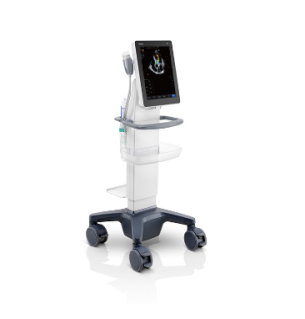A Smoother Dialogue with the Machine

Industrial Designer
More screen, less work
While designing the MX series, Mindray design team found that when medical professionals used ultrasound devices, they often needed to check the battery level when the device was in standby mode or had been shut down. Just as when checking the time on a mobile phone, it was necessary yet troublesome to wake the device repeatedly. In addition, medical professionals in each department pasted various identification labels on the device, which were neither appealing nor stayed in place very well. The three-screen design, especially the screen that displays battery percentage, has made customization with labels much easier.
New opportunities for voice control
To prevent cross infection and make the interface interaction even smarter and faster, the Mindray design team equipped the TE7 with voice recognition. Clinicians can activate the voice recognition component of iVocal by selecting the iVocal feature on the system and then tapping the Play button. With these simple clicks, the TE7 is all set to perform its tasks as assigned by the operator via voice command, and medical staff can now save time for clinical tasks and avoid touching the screen to reduce the infection risk. The application of voice control technology in ultrasound devices marks a big step forward for the ultrasound workflow.

Prepared for different habits and needs
The design team consider the different needs of medical professionals in the ICU, at the patients’ bedside, and in the imaging department, and provided portable ultrasound users with customized control panel design models – fully touchscreen, mechanical + touch, and fully mechanical. This allows users to choose the model that they feel most comfortable with. Another typical customization in ultrasound design is the use of electronic ink. In a hospital, different departments often share the same ultrasound device. Since different ultrasound procedures follow different protocols, it was the design team’s task to develop focused and customized point-of-care protocols to reduce exam times. As a result, the design team introduced electronic ink to the ultrasound system, which clinicians can use to define the functions on display themselves, making the imaging performance faster and easier.
Maximum Comfort through Intuitive Interactions

Industrial Designer

Making mobile DR more mobile
Medical staff often find it hard to carry bulky mobile DR to patients’ bedsides for X-ray examination. To optimize the user experience, the design team looked for ways to make the MobiEye 700 more flexible and intelligent. With its compact size, unique bionic manipulator, intelligent speed regulation, multiple control mode, and maximum examination coverage, medical staff can now easily move and turn the Mobile Radiography System one-handed. The anti-collision design, detector security technology, exposure status LED indicator, superior battery capacity and auto/manual motion mode also guarantee the machine's reliability. The design of the MobiEye 700 not only breaks the stereotype of bulkiness for traditional mobile DR systems, it also overturns the concept of inefficiency linked to bedside X-ray examinations. Moreover, the patented energy management system is designed to contribute to a greener environment.
Keeping everything, in the basket
Portable ultrasound systems are often transferred to different floors and buildings. The documents placed in the trolley storage basket can be blown away by the wind or soaked by the rain. In response, the team designed a storage basket that can be freely modified. The upper tray can be used as the lid of the lower storage basket to prevent items from falling out, and increase the storage space compared to the previous design.


Taking everyone into count
Ergonomic comfort and safety was a primary focus when the design team developed the MX series. Considering the various body sizes from Asian female to Caucasian male, as well as different clinical scenarios where the device is used, the design team determined the ideal height of the trolley, but ensured that it could be adjusted to the widest range of clinical settings and heights.
Managing cables more conveniently
Healthcare professionals in POC often believe cables are their enemy – indeed, who wants to see a wire swinging in front of their face or lying across the floor when working in a highly demanding workplace? To remove these irritations, the design team put several new ideas into practice: a medical-grade magnetic power socket that prevents cable strain, a convenient probe extender, etc. Easy cable management allows clinicians to better focus on their work and deliver quality care to patients.

In today's fast-paced and crowded hospital settings, clinicians are challenged to deliver accurate patient assessments rapidly and to perform routine interventions quickly and effectively. Through close-knit work with medical professionals and Mindray R&D teams, as well as careful observation and repetitive tests, Mindray’s design team optimizes user experience for clinicians. With a human-centric design philosophy at the heart of what we do, Mindray will continue designing medical imaging devices that elevate human-device and interface interactions, making healthcare providers' lives easier and allowing them to deliver better care to patients.

